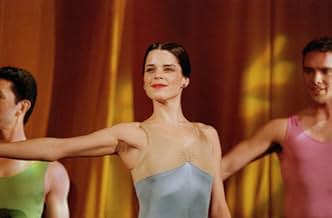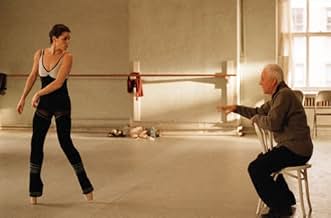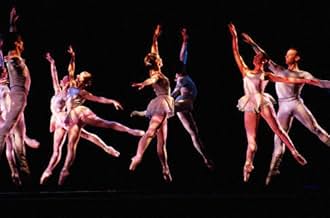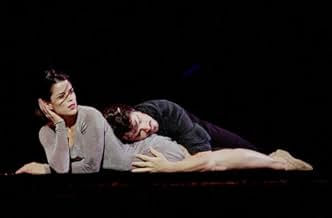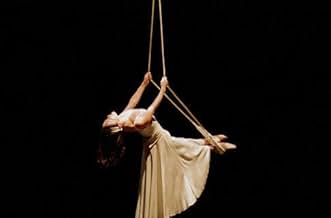NOTE IMDb
6,2/10
7 k
MA NOTE
Ajouter une intrigue dans votre langueA young ballet dancer is poised to become the principal performer in a group of ballet dancers.A young ballet dancer is poised to become the principal performer in a group of ballet dancers.A young ballet dancer is poised to become the principal performer in a group of ballet dancers.
- Réalisation
- Scénario
- Casting principal
- Récompenses
- 2 nominations au total
Barbara E. Robertson
- Harriet
- (as Barbara Robertson)
Davis C. Robertson
- Alec - Joffrey Dancer
- (as Davis Robertson)
Avis à la une
Some of the dances are tiny religious experiences. The film doesn't look nearly as good as some of Altman's others, but there are flashes of awesome beauty: a topless male dancer alone in a room with golden beams of light, and Neve Campbell in her bath. The movie looks at the queeny pretensions of the boys (and their fathers), the dancers' sex lives (who are more '60s than their instructor knows), and the company leader, played by Malcolm McDowell, whose occasional flakiness is caught by one black dancer. I couldn't help but think of McDowell as an Altman self-criticism: an elderly director working with small budgets, prone to artiness, who champions art as being organic, who rounds up a large crew of performers and calls them "babies." The day-in-the-life shapelessness of the movie didn't at all bother me, though one character, who asks to stay in a dancer's apartment, is dropped pretty quickly. And James Franco is in it. 9/10
I'm no dance critic, but. . . I was very disappointed with the choice of "The Blue Snake" as the ultimate and climactic "number" in "The Company". To me, it really stood out as the least interesting and most cliched of all the dances in the film. Those outrageous costumes! That "Ice Capades" choreography! Altman & Co. really ought to have chosen a piece that would have shown the Joffrey's more adventuresome side.
I went into this film knowing that it was a "dance movie" with minimal storyline, and I was still disappointed. It's not a good sign when I start looking at my watch halfway through a film. It doesn't bother me that a "dance film" eschews the Melodrama of "The Turning Point" or "A Chorus Line." But "The Company" also eschews Interest! There was basically nothing to "hang onto" outside the dance sequences. Only Ry (Neve Campbell's character) was given any appreciable screentime, and aside from a few quiet moments, she wasn't given very much to do.
Okay, I admit that I liked one dramatic scene a lot: a flirtatious moment between Ry and Josh - the chef who looks like a male model - which takes place in a dive bar. There should have been more scenes like that.
I rate the film a 6 - dramatically disappointing, while the quality of the dance sequences varies from sublime to ridiculous.
I went into this film knowing that it was a "dance movie" with minimal storyline, and I was still disappointed. It's not a good sign when I start looking at my watch halfway through a film. It doesn't bother me that a "dance film" eschews the Melodrama of "The Turning Point" or "A Chorus Line." But "The Company" also eschews Interest! There was basically nothing to "hang onto" outside the dance sequences. Only Ry (Neve Campbell's character) was given any appreciable screentime, and aside from a few quiet moments, she wasn't given very much to do.
Okay, I admit that I liked one dramatic scene a lot: a flirtatious moment between Ry and Josh - the chef who looks like a male model - which takes place in a dive bar. There should have been more scenes like that.
I rate the film a 6 - dramatically disappointing, while the quality of the dance sequences varies from sublime to ridiculous.
Lets hope that Altman makes films for another 20 years and that he stays as adventuresome as he currently is.
In 'The Long Goodbye' Altman invented a rather new camera stance, literally asking the actors to improvise staging and having the camera discovering them.
It took a few decades for him to get back to such experiments with 'Gosford.' Now he takes it even further with perhaps the purest problem in film cinematography: how do you film dance?
Forget that this features Campbell in a vanity role: she is good enough and doesn't detract. Forget about any modicum of plot: there isn't any. And unlike 'Nashville' or the similarly selfreferential 'Player' there is no cynical commentary.
The commentary itself is selfreferential this time. Yes, this time the center of the film is how 'Mr A' orchestrates movement and images. This is most of all about himself, and is far, far more intelligent and subtle than say, 'Blowup.'
But along the way, you get possibly the best dance experience on film. That's because they've been able to use many cameras. There are not as many as 'Dancer in the Dark,' but each camera dances, engages with the dance and the dance of people and objects around the dance. So we get four layers of dance: the actual ballet, the orchestration of people around the production, the dancing cameras (enhanced by non-radical appearing radical editing) and the dance within the mind of Mr A who encourages, follows and captures them all.
Ted's Evaluation -- 3 of 3: Worth watching.
In 'The Long Goodbye' Altman invented a rather new camera stance, literally asking the actors to improvise staging and having the camera discovering them.
It took a few decades for him to get back to such experiments with 'Gosford.' Now he takes it even further with perhaps the purest problem in film cinematography: how do you film dance?
Forget that this features Campbell in a vanity role: she is good enough and doesn't detract. Forget about any modicum of plot: there isn't any. And unlike 'Nashville' or the similarly selfreferential 'Player' there is no cynical commentary.
The commentary itself is selfreferential this time. Yes, this time the center of the film is how 'Mr A' orchestrates movement and images. This is most of all about himself, and is far, far more intelligent and subtle than say, 'Blowup.'
But along the way, you get possibly the best dance experience on film. That's because they've been able to use many cameras. There are not as many as 'Dancer in the Dark,' but each camera dances, engages with the dance and the dance of people and objects around the dance. So we get four layers of dance: the actual ballet, the orchestration of people around the production, the dancing cameras (enhanced by non-radical appearing radical editing) and the dance within the mind of Mr A who encourages, follows and captures them all.
Ted's Evaluation -- 3 of 3: Worth watching.
The DVD extras with some movies make the film seem better than it did just watching it. "The Company" is a good example.
I'd wondered, briefly, why star Neve Campbell also got producer credit. The DVD 'making of' documentary explains that the whole project was her idea; she'd been a dancer long before she took up acting, and wanted to combine the two. She chose Altman to direct, because of his skill at portraying relations and interactions among people in groups.
Altman did a fine job depicting dance, both rehearsals and performances. Campbell showed she can still dance. Malcolm McDowell gave a great performance as the acerbic company director. The Joffrey dancers were brilliant. Altman has created a dazzling cinematic album of what the world of dance is like at the beginning of the 21st century.
But the story arc was weak. This was no accident. In a recent (October 2004) interview, Altman said:
Question: "Why do you think you're drawn to stories about big groups of people sharing the same space? Did it have anything to do with growing up in such a large, close-knit family?"
Robert Altman: "Possibly. I don't know. That's a little too cerebral for me. I'm not much interested in stories anyway. I'm more interested in reactive behavior."
That sums up "The Company" very nicely. The movie is a montage of scenes of "reactive behavior" among realistic characters, and in this it is more like real life than a more structured story would have been.
Of course there is some story structure here, involving the creation of a new dance. This story is engaging, because the outside choreographer is a fey flake, and dance disaster seems foredoomed. But the dancers, being good soldiers, follow his orders diligently. And despite all expectations, at least all of my expectations, their climactic performance is superb.
But this story is not central to the movie. Again like life, it unfolds amidst all sorts of other organizational and interpersonal drama.
And for this reason the movie left me unsatisfied. Part of what I look for in movies, and in books, is a story arc: a beginning, a middle, and an end. I look for this precisely because life is rarely that neat. Many directors deliver this arc (and many more try to, and fail). Robert Altman chose not to try. He is free to do that, and I am free to rate this movie 7/10.
I'd wondered, briefly, why star Neve Campbell also got producer credit. The DVD 'making of' documentary explains that the whole project was her idea; she'd been a dancer long before she took up acting, and wanted to combine the two. She chose Altman to direct, because of his skill at portraying relations and interactions among people in groups.
Altman did a fine job depicting dance, both rehearsals and performances. Campbell showed she can still dance. Malcolm McDowell gave a great performance as the acerbic company director. The Joffrey dancers were brilliant. Altman has created a dazzling cinematic album of what the world of dance is like at the beginning of the 21st century.
But the story arc was weak. This was no accident. In a recent (October 2004) interview, Altman said:
Question: "Why do you think you're drawn to stories about big groups of people sharing the same space? Did it have anything to do with growing up in such a large, close-knit family?"
Robert Altman: "Possibly. I don't know. That's a little too cerebral for me. I'm not much interested in stories anyway. I'm more interested in reactive behavior."
That sums up "The Company" very nicely. The movie is a montage of scenes of "reactive behavior" among realistic characters, and in this it is more like real life than a more structured story would have been.
Of course there is some story structure here, involving the creation of a new dance. This story is engaging, because the outside choreographer is a fey flake, and dance disaster seems foredoomed. But the dancers, being good soldiers, follow his orders diligently. And despite all expectations, at least all of my expectations, their climactic performance is superb.
But this story is not central to the movie. Again like life, it unfolds amidst all sorts of other organizational and interpersonal drama.
And for this reason the movie left me unsatisfied. Part of what I look for in movies, and in books, is a story arc: a beginning, a middle, and an end. I look for this precisely because life is rarely that neat. Many directors deliver this arc (and many more try to, and fail). Robert Altman chose not to try. He is free to do that, and I am free to rate this movie 7/10.
Ugh. The problem with The Company is that it's not a Robert Altman film. His touch is evident in the filmmaking and fly-on-the-Wall feel of the movie, but it's not his movie. It's Neve Campbell's, who wrote, produced, and starred in it. Campbell spent years with the national ballet and this movie was a labor of that passion. However, that is precisely where it goes wrong. It shoots for the wrong audience. Dancers will likely love this movie but they are the choir. They know how a dance company works, the back dealing and politics. They don't need this movie. The rest of us don't learn anything, or at least learn just enough to know that professional dancing is a horrible way to live. The dancing was beautiful, including Neve's, although she doesn't look quite as polished as her back ups in the company, but the characters were shallow and you are never given anything to grab onto to care about any of them. The only ones you root for the ones who are injured or fired so they can get out of that horrible horrible place. Such a disappointment on so many levels. The only thing that does come off well is the Joffrey. You actually leave the theater wondering if the Ballet company underwrote the production as a marketing expense.
Le saviez-vous
- AnecdotesNeve Campbell lost thousands of dollars of her own money to ensure that her fellow cast members received their wages.
- GaffesAt about 1:10 while counting during a rehearsal, Harriet skips the 6th count of 8.
- Citations
Alberto Antonelli: Ry, honey, let's scramble some ideas, instead of some asshole who contradicts me.
- Crédits fousAfter the closing credits begin rolling, the dancers continue to take their final bows, and the audience continues to applaud.
Meilleurs choix
Connectez-vous pour évaluer et suivre la liste de favoris afin de recevoir des recommandations personnalisées
- How long is The Company?Alimenté par Alexa
Détails
Box-office
- Budget
- 15 000 000 $US (estimé)
- Montant brut aux États-Unis et au Canada
- 2 283 914 $US
- Week-end de sortie aux États-Unis et au Canada
- 93 776 $US
- 28 déc. 2003
- Montant brut mondial
- 6 415 017 $US
- Durée
- 1h 52min(112 min)
- Couleur
- Mixage
- Rapport de forme
- 2.35 : 1
Contribuer à cette page
Suggérer une modification ou ajouter du contenu manquant








